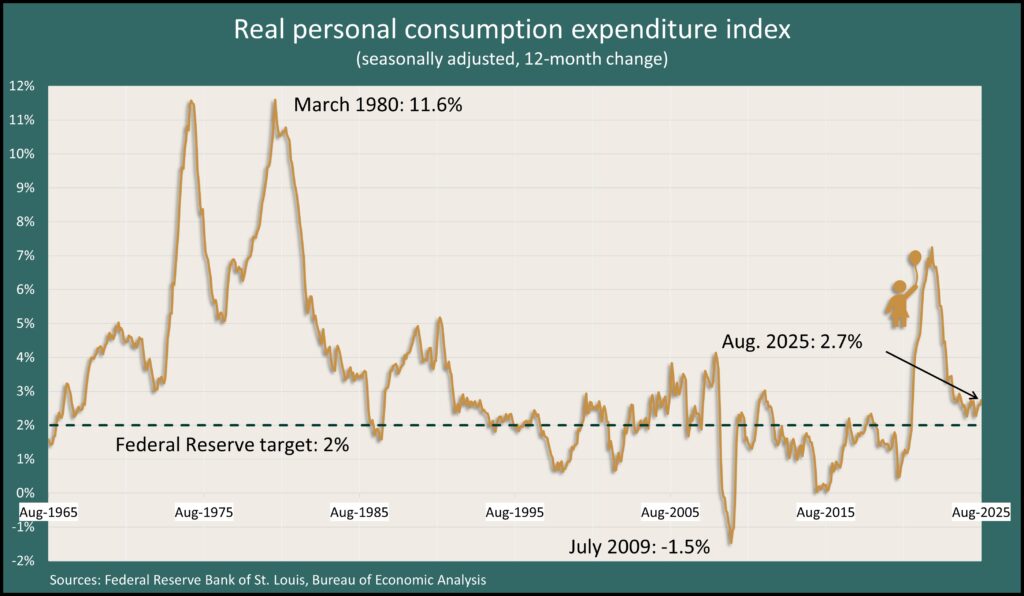
Each week in the Money Talk Podcast, Landaas & Company advisors offer insights for long-term investors. Try to answer the following questions, based on some of the recent Money Talk conversations.
1.
In the Sept. 5 Money Talk Podcast, Tom Pappenfus explained how a huge corporate trend may be making the U.S. economy appear stronger than it is. Which activity did Tom identify?
(Choose one.)
- Dividend payouts.
- Stock buybacks.
- Investments in artificial intelligence.
- Construction spending.
(See answer below.)
2.
Kendall Bauer explained on the Sept. 12 Money Talk Podcast what bondholders should expect as the Federal Reserve resumes cutting interest rates. In principle, what happens to bond values as rates decrease?
(Choose one.)
- Bond values decrease.
- Bond values increase.
- Bond values temporarily freeze.
- Bond values temporarily decrease.
(See answer below.)
3.
In the Sept. 12 Money Talk Podcast, Tom Pappenfus talked about research suggesting that the typical turnover of companies in an index fund can weaken performance. What type of fund did Tom mention as a good complement to index funds?
(Choose one.)
- Passive funds.
- Actively managed funds.
- Target-dated funds.
- Exchange-traded funds.
(See answer below.)
4.
As Adam Baley explained in the Sept. 19 Money Talk Podcast, what was the main driver of the Federal Reserve Board’s decision to resume reducing short-term interest rates?
(Choose one.)
- Stock prices.
- Inflation.
- Labor market.
- Mortgage rates.
(See answer below.)
5.
In the Sept. 19 Money Talk Podcast, Dave Sandstrom explained how the Fed has found it difficult to keep the inflation rate near the board’s long-term target. For more than a decade, inflation stayed below the mark, and lately it has run above it. What is the Fed’s target rate?
(Choose one.)
- 1%
- 2%
- 3%
- 4%
(See answer below.)
6.
In the Sept. 26 Money Talk Podcast, Steve Giles noted above-average returns on stocks so far in 2025. Because of that, what consideration did Steve say he has been advising many clients?
(Choose one.)
- Stay put.
- Buy more.
- Cash out.
- Rebalance.
(See answer below.)
Answers
1.
c. Investments in artificial intelligence.
Learn more
- Innovations, long-run opportunities,by Kyle Tetting
- AI vs. dot-com: What investors should know,by Kyle Tetting
- Implementing data, cultivating outlook, by Kyle Tetting
- AI: A Fed Policymaker’s View, from the Federal Reserve Board
2.
b. Bond values increase.
Learn more
- Markets surprise. What should investors do? by Kyle Tetting
- The Fed: What investors should know, a Money Talk Video with Dave Sandstrom
- Earnings yield: Valuing stocks vs. bonds, a Money Talk Video with Kyle Tetting
- Bonds also face investment risks, a Money Talk Video with Tom Pappenfus
3.
b. Actively managed funds
Learn more
- Staying active as conditions change
- When Should I …consider actively managed funds?
- The case for active funds amid volatility, a Money Talk Video with Kyle Tetting
- Sorting through investment fund managers, a Money Talk Video with Kyle Tetting
- “Active vs. Passive Management” in Mutual funds, from the Financial Industry Regulatory Authority
4.
c. Labor market
Learn more
- Federal Reserve issues FOMC statement,from the Federal Reserve Board
- Monetary Policy and the Fed’s Framework Review, from the Federal Reserve
- Powell Highlights Job Market Worries, Opening Path to Rate Cut, from the Wall Street Journal
- Time has come, Fed pivots focus, by Kyle Tetting
5.
b. 2%

Learn more
- What is inflation, and how does the Federal Reserve evaluate changes in the rate of inflation? from the Federal Reserve Board
- The Fed: What investors should know, a Money Talk Video with Dave Sandstrom
- Federal Reserve issues FOMC statement,from the Federal Reserve Board
6.
d. Rebalance.
Learn more
- Rebalancing: Too important to ignore, by Steve Giles
- When Should I …rebalance my portfolio?
Seeing how your equities are balanced, a Money Talk Video with Kyle Tetting
Rebalancing: More investing, less emotion, a Money Talk Video with Steve Giles
Beginners Guide to Asset Allocation, Diversification and Rebalancing, from the U.S. Securities and Exchange Commission